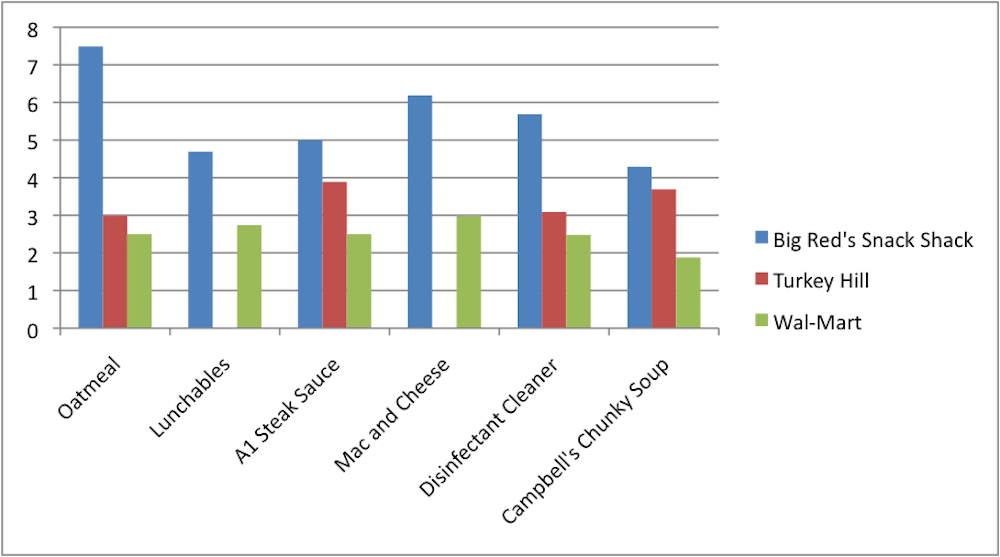It is a well-known fact that attending a college or university is a costly endeavor. Not only do students who pursue a degree have to pay for the tuition; there are many other costs that are incurred and added to the overall bill as well. One of these expenditures, specifically for those who live on-campus, is a meal plan.
At Shippensburg University, there are several meal plan options. Students can select the amount of meals they prefer per week, or purchase a certain amount of meal plans they can use throughout the semester.
For those students who do not eat many meals on campus, flex dollars can be purchased and used like cash at several on-campus locations. One of these locations is Big Red’s Snack Shack, a convenience store located in the Ceddia Union Building.
With all of the possible meal plan options for students, there seems to be a perfect plan for everyone.
There is, however, one aspect of purchasing a meal plan that many students do not agree with. Every student who signs up to receive meals on their plan is required to have either $250 or $375 in flex.
For young adults trying to pay their way through college, this amount of money is a large sum. Unfortunately for them, they do not have the choice to choose a lower amount of flex money.
Sebastian Sherlock, a senior criminal justice major at Shippensburg University, is one who feels students should be able to lower the amount of flex on their meal plans. Sherlock, who says he uses Big Red’s Snack Shack about five times a week, mostly purchases snacks and drinks from the convenience store. In his opinion, the prices at Big Red’s Snack Shack are reasonable.
“It’s not like there’s any competition that they have on campus, so it’s the fact that they’re the only game in town and the prices are still what I say are relatively low. It’s higher than Wal-Mart but what other options do students who can’t get off campus have?” Sherlock said.
Although Sherlock does not have a problem with the overall prices at Big Red’s Snack Shack, he would prefer to have the option to put less than $250 in flex on his meal plan. Some students, he said, have a hard time spending the $250 before the semester is over.
Although flex left on an account at the end of the fall semester rolls over to the spring semester, at the end of the school year, any flex that has not been spent is wiped clean from the meal plan.
Vice President of SU, Roger Serr, explained the reasoning behind the flex money. He said he was approached at some point with complaints that students wanted the opportunity to have more flex.
At this point, the decision was made to allow students to have either the original $250 or increase their flex amount to $375.
He said this gives students a higher option for those people who need it. The option to lower the amount of flex, however, was not addressed.
William Connor, Chartwells’ assistant director of retail dining, is in charge of setting the prices of the items sold at Big Red’s Snack Shack.
According to Connor, Chartwells’ contract with Shippensburg University states that the company has to charge students who have a meal plan either $250 or $375 in flex; no more, no less.
Unfortunately for Sherlock, this means that his issue with the required flex amount lies higher up with the university and not with the food provider, Chartwells.
Unlike Sherlock, there are students who do feel the prices at Big Red’s Snack Shack are higher than they need to be. Christina Pooler, a senior interdisciplinary art major at Shippensburg University, does not have a meal plan, but still adds flex money to her school ID to use around campus.
In her opinion, some of the prices at Big Red’s Snack Shack seem unreasonable. Also, the point that Chartwells is not competing for students’ business, which Sherlock viewed as a positive aspect, is a negative aspect in her eyes.
“Certain things are priced the way I would see them elsewhere, like candy bars are pretty reasonable, but other items are priced a little high. They don’t really have competition so they can make their prices basically whatever they want them to be.” Pooler said.
Pooler also addressed the issue that the younger students at SU rely on the convenience store more than the older ones who are able to shop at other locations off-campus.
Sierra Reigle, a senior at Shippensburg University, identified additional changes she would like to see for meal plans.
“I think there should be an option of seven meals a week for a meal plan because five might be too small and 10 too big,” she said.
In response to students’ negative feelings toward the prices at Big Red’s Snack Shack and the meal plan system in general, Connor gave an explanation of what factors into the final prices.
“We look at product costs. We have to look at our overhead costs.
We have to look at what it costs our staff to be here and what it costs for us to insure the place and any utilities or expenses. And then there is a commission that goes back to the university. Anything you purchase in the convenience store has a 5.3 percent add on that goes back to the university,” Connor said.
Serr explained that the 5.3 percent commission is used for the equipment, electricity and general maintenance of the dining facilities. It is the school’s responsibility to provide the equipment for Chartwells and to keep the facilities in working order, he said.
Nick Iula, the resident district manager of Chartwells, addressed the amount of money that Chartwells actually makes from the on-campus dining facilities.
The percent was surprisingly low, representing a typical profit for the food service industry.
Due to competition with other dining companies attempting to provide food for Shippensburg University, Iula requested the exact percentage be withheld. He did say that if their profit margin ever exceeds a certain amount, part of it is shared with the university.
Like Connor, Iula gave explanations of why some of their items are priced higher than the competition.
“We have to be open in the summer when business drops off and have expenses other places don’t have,” he said.
Additionally, he explained that places like Sheetz rely mostly on gasoline as their profit, while Big Red’s Snack Shack relies only on their convenience store items.
Connor also wants to ensure students understand that the rising cost of food also affects the prices found in Big Red’s Snack Shack.
According to a New York Time’s article, food prices increased 10 percent from June to July alone because of the drought that occurred in the western part of the U.S.. Connor explained that Chartwells, as with all businesses, strives to balance costs while making a profit.
The increased price of groceries makes it difficult to succeed in pleasing students, while also making a profit for the company.
“Prices are going up on a daily basis. We anticipate 2013 to be a higher spike than what we’ve seen this year in terms of costs of goods,” Connor said.
Although Connor’s reasons for the prices are realistic, some of the prices do seem rather high. The Quaker’s oatmeal, for instance, is priced at $7.49 at Big Red’s Snack Shack while it is sold for a mere $2.99 at local Turkey Hill stores.
Prices are competitive between the two stores for other items such as Campbell’s soup. Big Red’s Snack Shack sells it to students for $4.29 and Turkey Hill sells it for less than a dollar cheaper at $3.69.
There are obvious discrepancies between prices of various goods but overall, contrary to many students’ beliefs, Chartwells is making the typical profit of any food service industry.
Connor’s cost explanations help to give insight to students about why prices at Big Red’s Snack Shack are what they are. For the regular struggling college student, every penny counts. Because of this, it is obvious that students are curious about what their money is used for.
Connor wants the students to know that Chartwells does not try to take advantage of the student body. Overall though, the consensus of the student body seems to be that they want more options concerning flex dollar amounts.
Connor said, “Brenda [Kunkleman] and I are here for the students and part of our whole mentality is that we want to have every generation of student that comes through the university to have a better experience than the one before.”





The Slate welcomes thoughtful discussion on all of our stories, but please keep comments civil and on-topic. Read our full guidelines here.